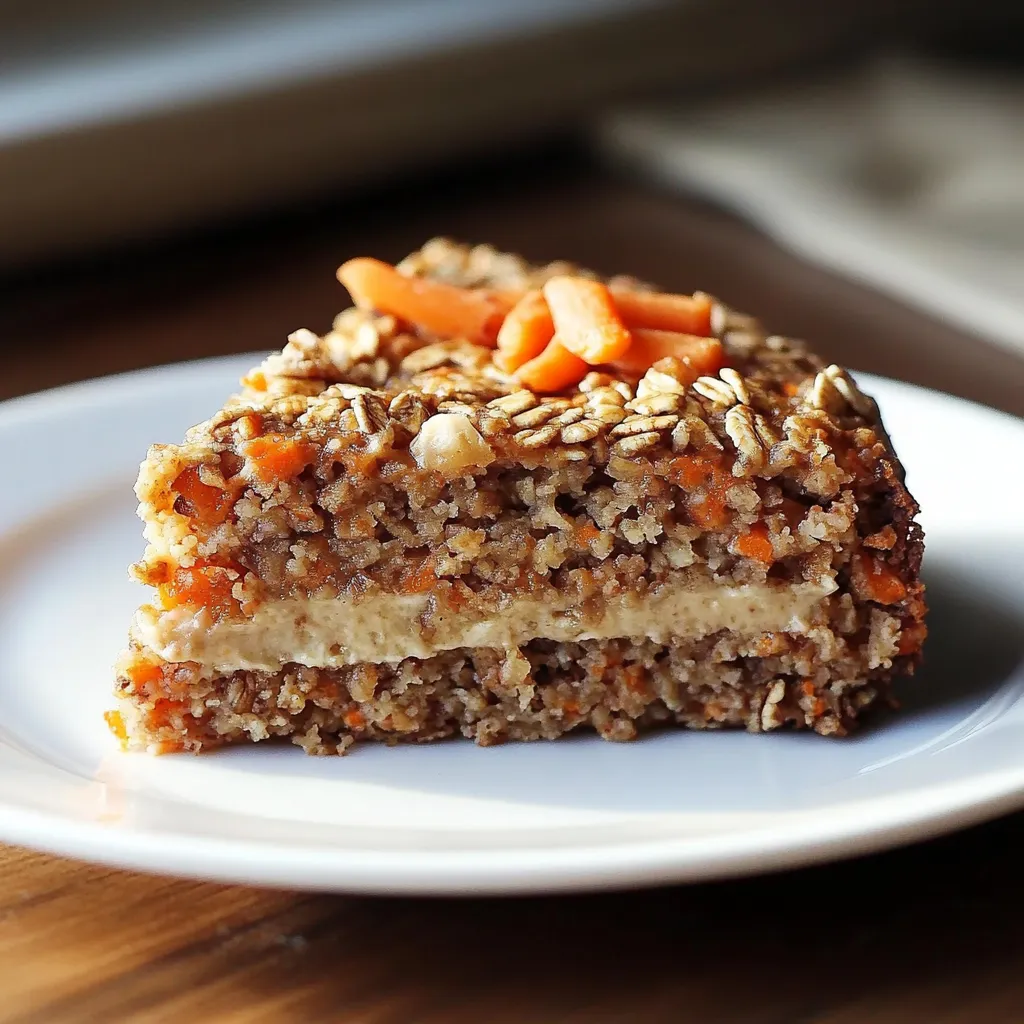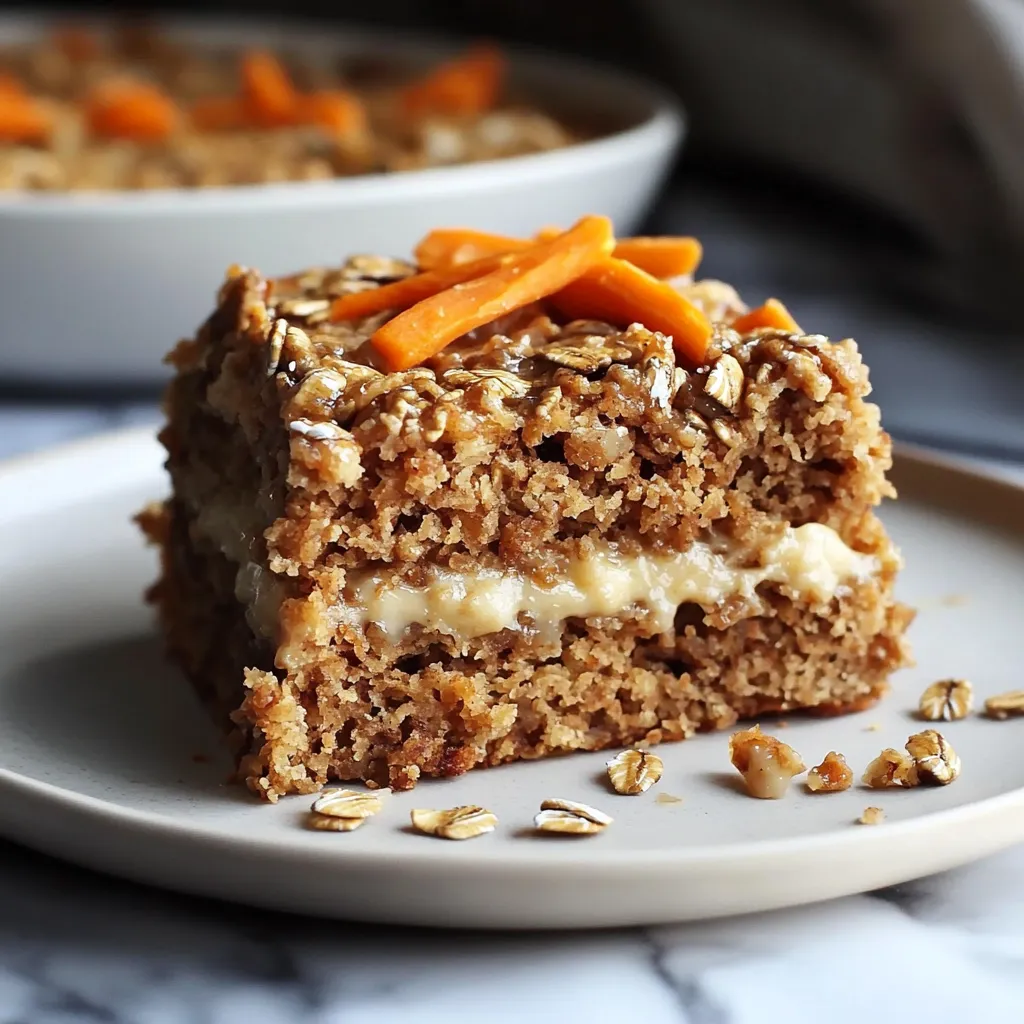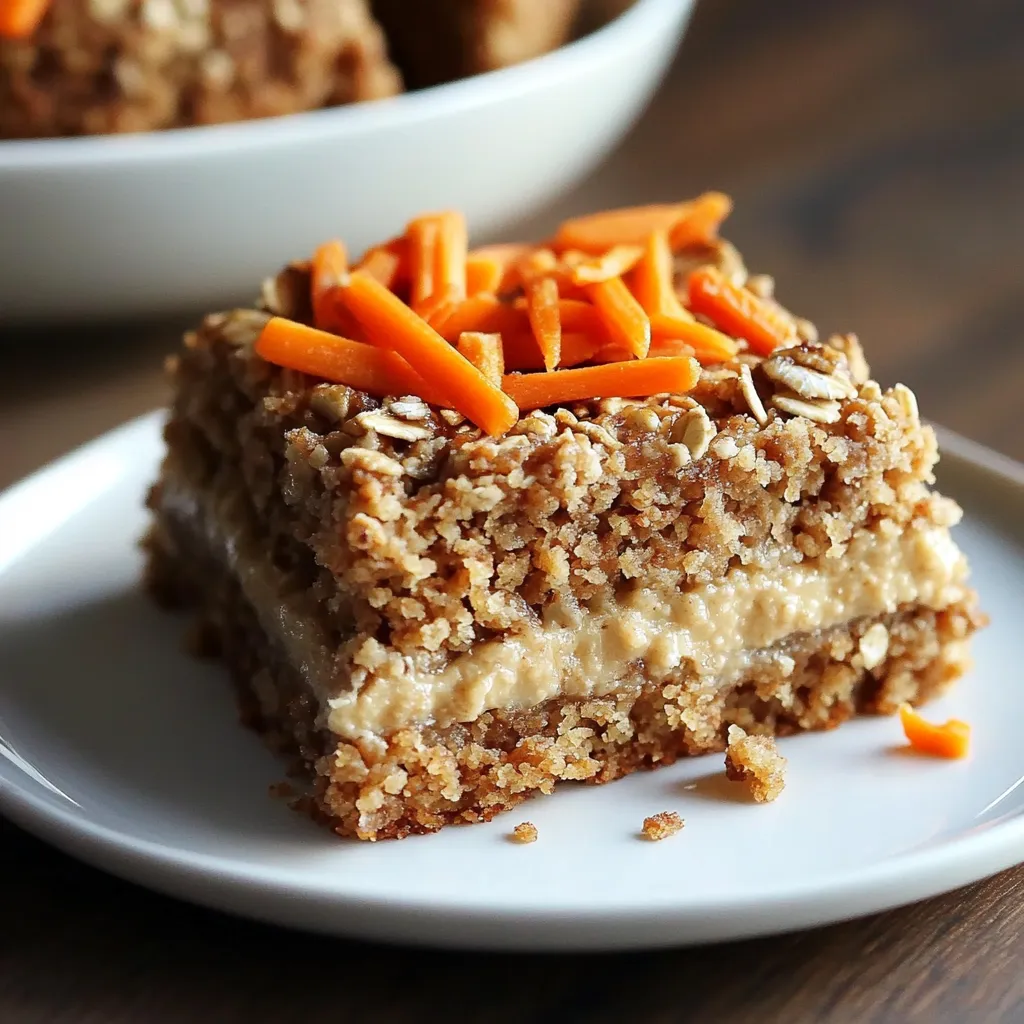 Pin it
Pin it
This flourless oatmeal carrot cake transforms ordinary ingredients into a delightful treat that satisfies your sweet tooth without the refined flour. The natural sweetness of carrots blends perfectly with warm spices, creating a moist cake that's nutritious enough for breakfast yet decadent enough for dessert.
I first created this recipe when my daughter was diagnosed with a gluten sensitivity, and it quickly became our family's favorite weekend breakfast treat. Even my husband, who typically reaches for traditional baked goods, requests this carrot cake regularly.
Ingredients
- Old fashioned oats: Provide the perfect flour substitute with a nutty flavor and excellent texture. Look for thick cut varieties for the best result.
- Baking powder and baking soda: Work together to create the perfect rise in this dense, nutrient rich cake.
- Cinnamon, ginger, and nutmeg: Create that classic carrot cake flavor profile. Always use fresh spices for the most vibrant taste.
- Eggs: Act as the binding agent. Room temperature eggs incorporate better into the batter.
- Unsweetened applesauce: Adds moisture without extra fat or sugar. Choose a no sugar added variety.
- Maple syrup: Offers natural sweetness with beneficial minerals. Opt for pure maple syrup rather than pancake syrup.
- Almond milk: Keeps the batter light. Any plant based or dairy milk works well.
- Vanilla extract: Enhances all the flavors. Pure extract yields the best results.
- Shredded carrots: Provide natural sweetness, moisture, and nutrition. Freshly grated carrots contain more moisture than pre shredded.
- Walnuts or pecans: Add wonderful texture and healthy fats. Toast them lightly beforehand for enhanced flavor.
- Raisins or dried cranberries: Contribute chewy sweetness. Choose unsweetened varieties when possible.
Step-by-Step Instructions
- Prepare the Pan:
- Thoroughly grease your 8 inch cake pan, making sure to get into all corners and crevices. Alternatively, cut parchment paper to fit the bottom and sides of the pan for foolproof release. This step ensures your cake comes out perfectly intact.
- Create Oat Flour:
- Process your oats in a blender or food processor using pulses until you achieve a fine, flour like consistency, about 30 to 45 seconds. Avoid over processing which can make the oats release oils and become pasty. The texture should resemble whole wheat flour.
- Combine Dry Ingredients:
- In a medium bowl, whisk together your freshly made oat flour with the baking powder, baking soda, and all spices. This ensures even distribution of the leavening agents and spices throughout the batter, preventing any bitter spots from concentrated baking powder or soda.
- Mix Wet Ingredients:
- Whisk eggs vigorously until slightly frothy before adding the applesauce, maple syrup, almond milk, and vanilla. Whisk until completely homogenous. The mixture should be smooth and well incorporated to ensure even sweetness and moisture throughout your cake.
- Combine Wet and Dry Mixtures:
- Add your dry ingredients to the wet ingredients in two batches, gently stirring after each addition just until no dry streaks remain. Overmixing will develop the proteins in the oats and result in a tougher cake texture, so use a light hand with about 10 to 15 gentle folds.
- Fold in Carrots and Mix Ins:
- Using a rubber spatula, gently incorporate the shredded carrots, nuts, and dried fruit with about 5 to 7 folding motions. The carrots should be evenly distributed throughout the batter, which will now be thick but still pourable.
- Bake to Perfection:
- Pour the batter into your prepared pan, using the spatula to spread it evenly to the edges. The surface should be relatively flat. Bake in your preheated oven for exactly 30 minutes, then check with a toothpick inserted in the center. It should come out with a few moist crumbs, not wet batter.
- Cool Properly:
- Allow the cake to rest in the pan for precisely 10 minutes. This cooling period helps the cake structure set while still warm enough to release easily. Then carefully invert onto a cooling rack, remove the pan, and flip right side up to cool completely for at least 30 minutes before slicing.
 Pin it
Pin it
The secret to this recipe is properly grating the carrots. I learned that hand grating on the fine side of a box grater produces the perfect texture. When I first made this for my grandmother, she could not believe it contained no wheat flour. She said it reminded her of the carrot cakes she grew up with in the countryside, where simple, wholesome ingredients were transformed into something special.
 Pin it
Pin it
Make Ahead and Storage
This carrot cake actually improves with time as the flavors meld together. You can bake it up to three days in advance and store it in an airtight container at room temperature. For longer storage, wrap individual slices tightly in plastic wrap and place them in a freezer bag. They freeze beautifully for up to three months. When ready to enjoy, thaw a slice at room temperature for about an hour or microwave for 20 seconds for a warm treat.
Perfect Variations
The base recipe is incredibly versatile. For a tropical twist, add 1/4 cup of shredded coconut and replace the nuts with chopped pineapple. Chocolate lovers can fold in 1/4 cup mini chocolate chips. For extra protein, replace 1/4 cup of the oats with unflavored protein powder. During fall, try adding 1/4 cup of pumpkin puree in place of some of the applesauce and increasing the spices slightly. Each variation maintains the moist texture while offering a new flavor profile.
Serving Suggestions
While delicious on its own, this carrot cake transforms into a more decadent dessert when topped with a simple Greek yogurt frosting. Mix 1 cup of Greek yogurt with 2 tablespoons of maple syrup and a splash of vanilla, then spread over the cooled cake. For breakfast, serve slightly warmed with a dollop of almond butter or alongside fresh fruit. For an elegant brunch presentation, dust with a light sprinkle of powdered sugar and garnish with edible flowers.
Cultural Context
Carrot cakes have been enjoyed for centuries, with origins dating back to medieval times when sugar was scarce and expensive. Carrots were used as a natural sweetener in baked goods throughout Europe. This modern, flourless version connects to that tradition while catering to contemporary dietary preferences. The oats add a distinctly Scandinavian touch, where hearty grains are celebrated in both sweet and savory dishes. This recipe honors those culinary traditions while creating something accessible for today's health conscious eaters.
Frequently Asked Questions
- → Can I use instant oats instead of old-fashioned oats?
Old-fashioned oats work best since they can be blended into a fine flour-like texture. Instant oats may result in a softer or denser texture but can be used in a pinch.
- → How do I make this cake dairy-free?
Simply use almond milk or another non-dairy milk variety and skip any dairy-based toppings like cream cheese frosting.
- → Can I substitute applesauce with another ingredient?
Applesauce can be replaced with mashed banana or even pumpkin puree for a slightly different flavor profile. Be sure to keep the same quantity.
- → What’s the best way to shred carrots for this cake?
Use the smallest grater side or a food processor for fine shredding. This ensures the carrots blend well into the batter and keep the cake moist.
- → How do I store leftover cake?
Store leftovers in an airtight container in the fridge for up to 4 days. You can also freeze slices for up to 2 months. Thaw at room temperature before serving.
- → Are the nuts and dried fruits necessary?
No, these are optional and can be omitted if you prefer a smoother texture. However, they do add a delicious crunch and flavor contrast.
- → Can I make this cake vegan?
Yes, replace the eggs with flax eggs (2 tablespoons ground flaxseed mixed with 6 tablespoons water) and use non-dairy milk. Adjust sweetness as needed.
